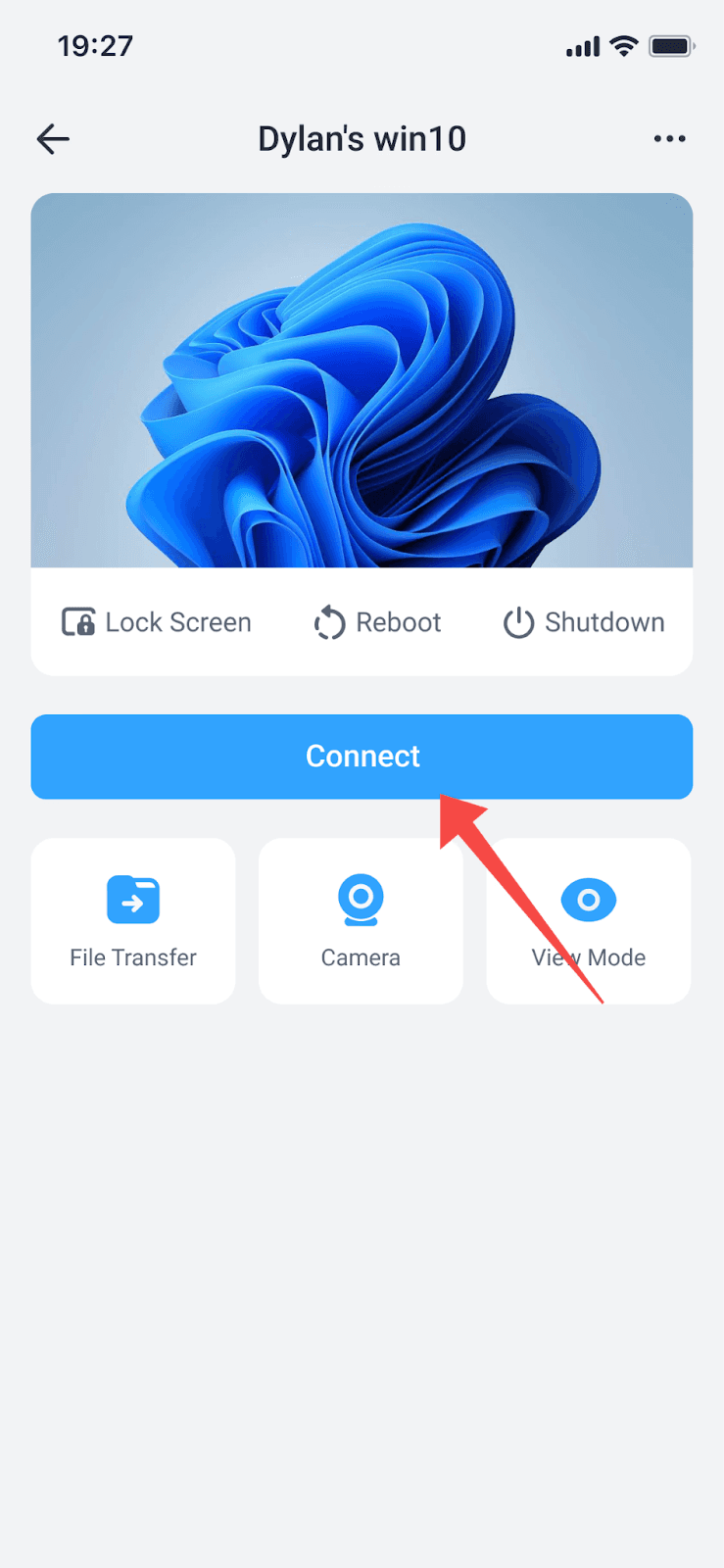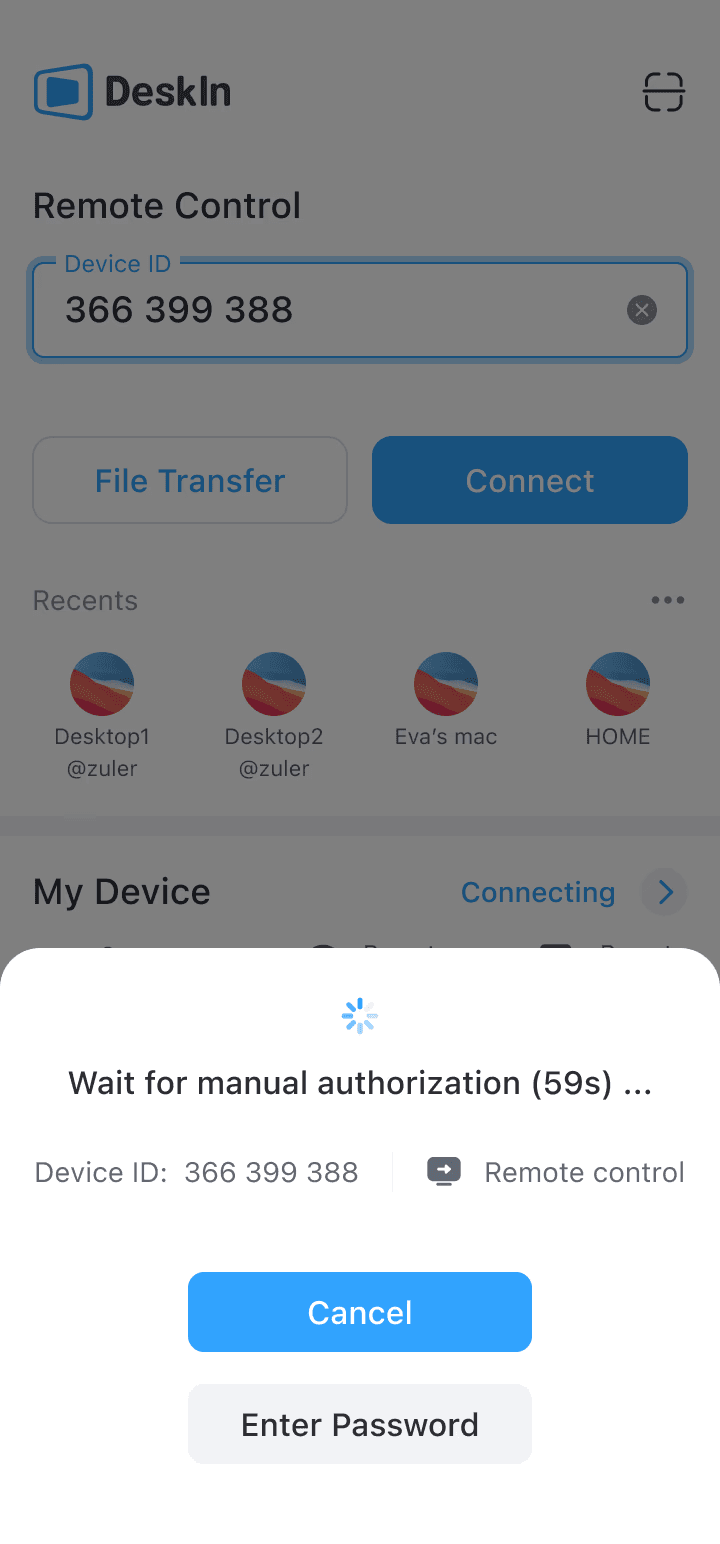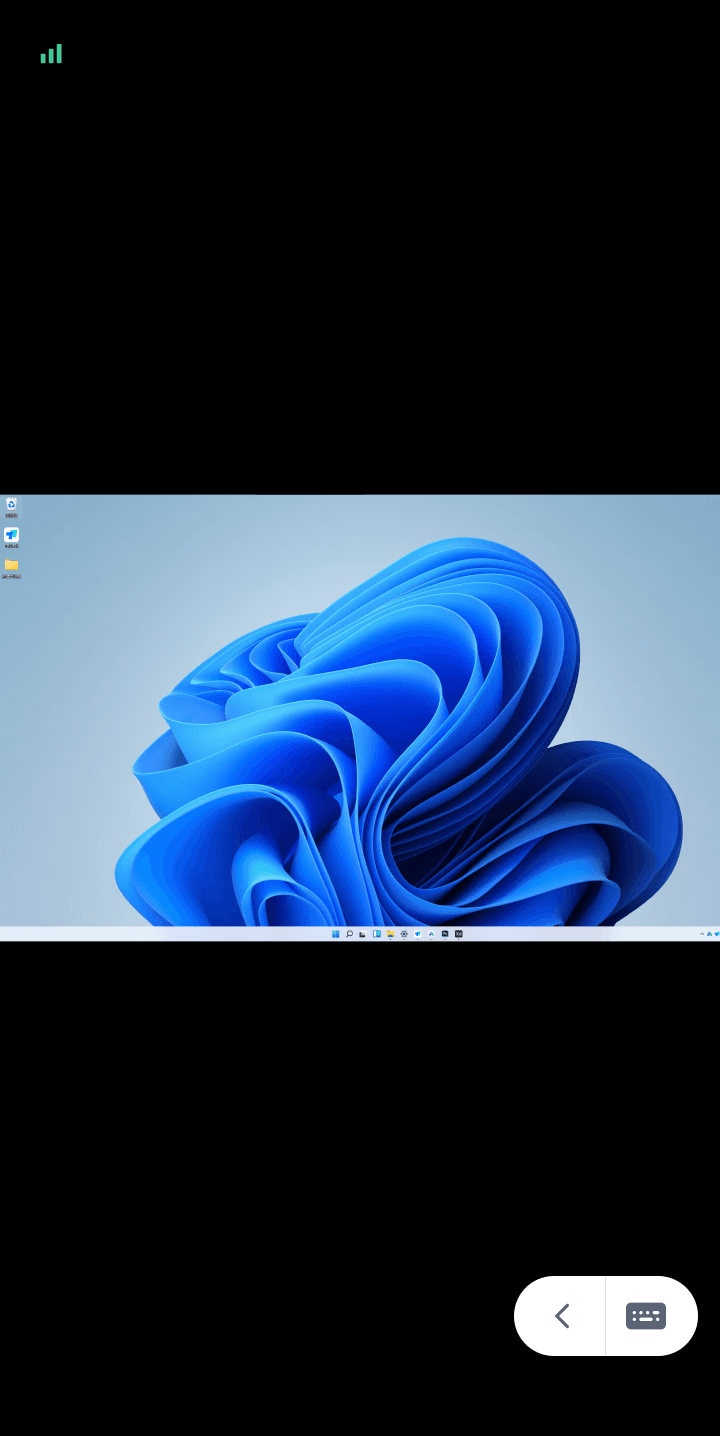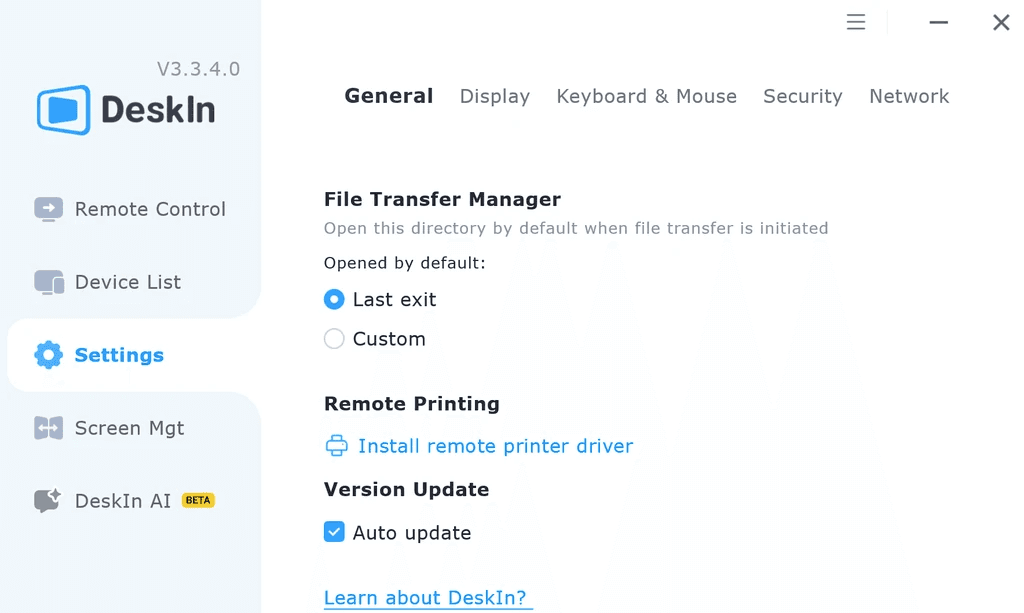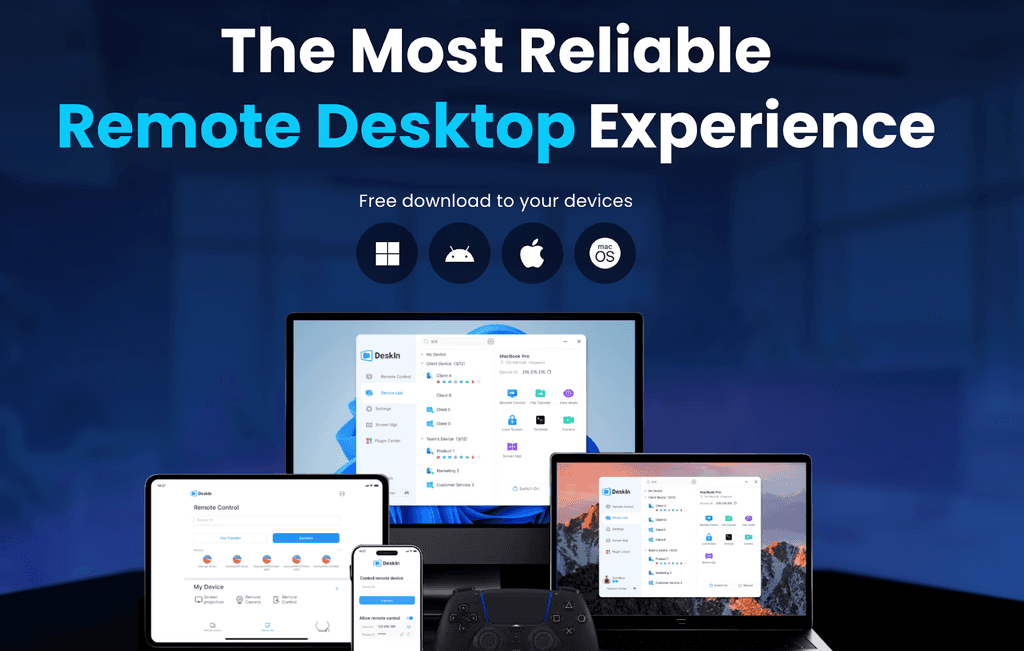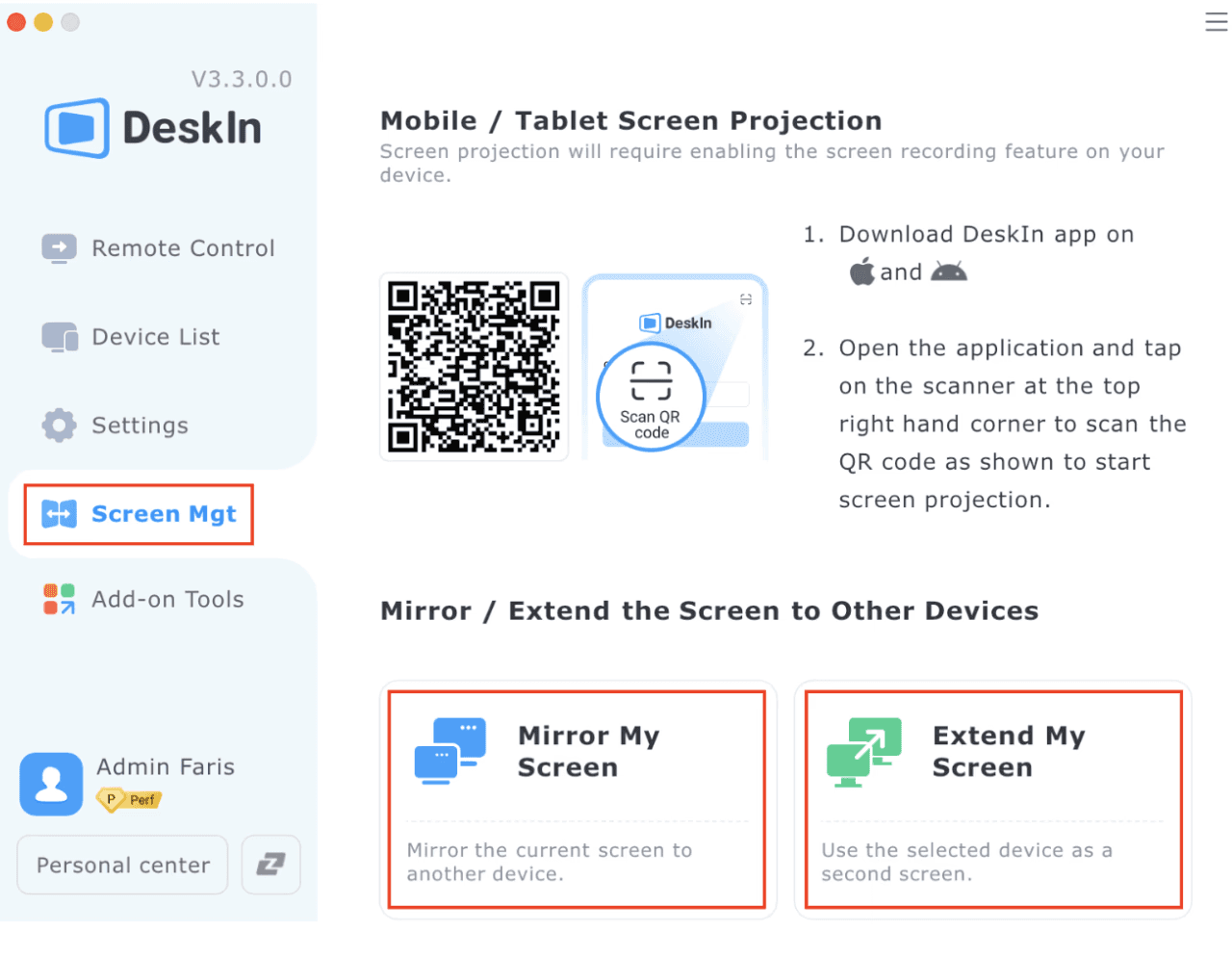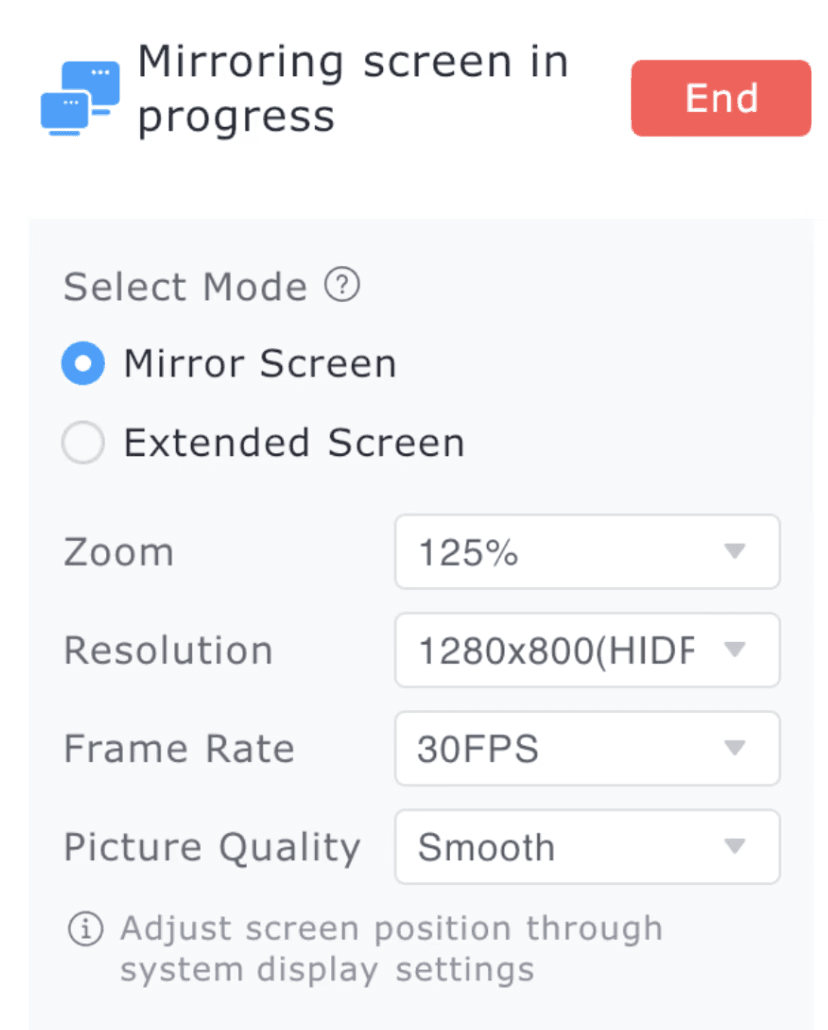Ứng dụng Windows App Remote Desktop: Kết nối đến Windows một cách dễ dàng
Nếu bạn đã sử dụng ứng dụng Remote Desktop của Microsoft, bạn có thể đã nhận thấy một số thay đổi gần đây gây ra câu hỏi về việc bạn có đang sử dụng đúng phiên bản hay không, hoặc liệu có điều gì đó đã sai. Bắt đầu từ ngày 27 tháng 5 năm 2025, ứng dụng Remote Desktop sẽ không còn được hỗ trợ. Microsoft đang thay thế nó bằng Windows App mới, được thiết kế để cung cấp tích hợp tốt hơn với các dịch vụ như Windows 365, Azure Virtual Desktop và RemoteApp.
Trong hướng dẫn này, chúng tôi sẽ hướng dẫn bạn cách sử dụng Windows App, cách cài đặt nó, sử dụng hiệu quả và khám phá các tính năng chính của nó. Chúng tôi cũng sẽ giới thiệu một giải pháp thay thế, DeskIn, mà có thể phù hợp hơn với nhu cầu remote desktop của bạn tùy thuộc vào trường hợp sử dụng cụ thể. Nhấn vào đây để tải DeskIn.
Tổng quan: Microsoft Remote Desktop vs. Ứng dụng Windows
Nếu bạn đã sử dụng Microsoft Remote Desktop trên Mac, có thể bạn đã nhận thấy sự thay đổi gần đây về tên gọi và chức năng, vì Microsoft đã phát hành ứng dụng Windows App thống nhất trên App Store của Mac. Nó phản ánh sự chuyển mình của Microsoft hướng tới một nền tảng tích hợp hơn, cung cấp giải pháp toàn diện để kết nối với các thiết bị Windows, desktop ảo và dịch vụ đám mây.
Sự thay đổi này đã dẫn đến nhiều tài liệu tham khảo khác nhau trên các diễn đàn, trang hỗ trợ và nguồn tải xuống, khiến một số người dùng không chắc chắn liệu họ có đang sử dụng đúng phiên bản hay không, hoặc liệu có điều gì sai trong quá trình cài đặt. Khi Windows App trở thành công cụ tiêu chuẩn, điều quan trọng là hiểu các sự khác biệt và lý do tại sao cập nhật này lại có lợi cho việc truy cập remote desktop.
Sự khác biệt là gì?
Trong nhiều năm qua, ứng dụng Microsoft Remote Desktop là công cụ chính để kết nối từ macOS tới các máy tính Windows. Tuy nhiên, vào năm 2024, Microsoft đã đổi tên giải pháp remote desktop của mình dưới thương hiệu Windows App. Windows App thay thế client Microsoft Remote Desktop cũ và giới thiệu nhiều cải tiến đáng kể, bao gồm tích hợp nâng cao với Windows 365, Azure Virtual Desktop và các dịch vụ Microsoft khác.
Khi Microsoft Remote Desktop đang dần ngừng hoạt động, nếu bạn vẫn muốn tận hưởng sự linh hoạt của việc điều khiển từ xa, nên chuyển sang Windows App để tiếp tục nhận hỗ trợ, cập nhật bảo mật và truy cập vào các tính năng mới được thiết kế để cải thiện trải nghiệm truy cập từ xa của bạn.
Hỗ trợ nền tảng
Windows App giờ đây là giải pháp hàng đầu cho việc truy cập remote desktop trên nhiều nền tảng:
macOS (phiên bản 12 trở lên)
Windows 10/11
iOS/iPadOS
Web (bản xem trước)
Khi ứng dụng Microsoft Remote Desktop là tùy chọn ưa thích trong quá khứ, Windows App giờ đây cung cấp khả năng tương thích mở rộng và giao diện hiện đại hơn cho người dùng trên các thiết bị khác nhau. Đối với người dùng macOS đang tìm cách điều khiển các máy tính Windows từ xa, Windows App cung cấp một cách tiếp cận tinh gọn và hiệu quả để quản lý các kết nối từ xa, đảm bảo trải nghiệm mượt mà hơn trên các nền tảng khác nhau.
Cách sử dụng Windows App để truy cập Remote Desktop
Giờ đây khi bạn đã hiểu sự khác biệt giữa Microsoft Remote Desktop và Windows App mới, đã đến lúc xem cách hoạt động của trải nghiệm cập nhật. Dù bạn đang truy cập một PC từ xa, đăng nhập vào Cloud PC từ máy tính bảng, hay quản lý một desktop ảo trong Azure, Windows App đơn giản hóa quá trình với một thiết lập trực quan hơn. Dưới đây là cách bắt đầu.
Bước 1: Tải về Windows App
Để bắt đầu, bạn cần cài đặt Windows App trên thiết bị của mình. May mắn thay, Windows App cho desktop có sẵn trên nhiều nền tảng:
Windows: Có sẵn qua Microsoft Store.
macOS: Tải về qua Mac App Store.
iOS / iPadOS / Android: Có sẵn trên App Store và Google Play.
Bản web: Truy cập qua các trình duyệt hỗ trợ tại "https://windows.cloud.microsoft".
Nếu bạn vẫn đang tìm kiếm nơi để lấy công cụ này, chỉ cần tìm "tải Windows App" trong cửa hàng ứng dụng của thiết bị bạn hoặc truy cập trang web chính thức của Microsoft.

📌 Mẹo: Hãy chắc chắn rằng hệ điều hành của bạn đáp ứng các yêu cầu tối thiểu. Trên Windows, ví dụ, bạn sẽ cần Windows 10 phiên bản 1903 trở lên.
Bước 2: Thêm một kết nối mới
Ngay khi đã cài đặt, khởi động Windows App và nhấp vào "+ Thêm" để bắt đầu tạo kết nối đầu tiên của bạn. Bạn sẽ được yêu cầu chọn từ một số loại kết nối:
PC từ xa: Nhập địa chỉ IP hoặc tên của máy tính Windows mà bạn muốn điều khiển. Tùy chọn này rất lý tưởng cho việc truy cập trực tiếp.
Các không gian làm việc: Đây là những không gian đã được cấu hình trước bởi tổ chức của bạn và có thể bao gồm các desktop ảo hoặc chương trình RemoteApp.
Cloud PC / Windows 365: Đăng nhập bằng tài khoản Microsoft 365 của bạn để truy cập vào desktop được lưu trữ trên đám mây.
Azure Virtual Desktop: Dành cho sử dụng doanh nghiệp, đăng nhập bằng tài khoản làm việc của bạn để kết nối đến các môi trường ảo được lưu trữ trên Azure.
Sau khi nhập thông tin cần thiết, hãy lưu kết nối để truy cập nhanh chóng sau này.
Bước 3: Kết nối và điều khiển
Sau khi kết nối của bạn được thiết lập, chỉ cần chọn nó từ danh sách của bạn và nhấp vào "Kết nối". Bạn sẽ được yêu cầu nhập thông tin xác thực của mình (nếu không được lưu trước đó), và chỉ trong vài giây, bạn sẽ điều khiển được môi trường từ xa của mình.
Bạn có thể tương tác với PC từ xa như bạn sẽ làm trên một máy tính cục bộ, mở tệp, chạy ứng dụng và thậm chí sử dụng nhiều màn hình (nếu được hỗ trợ). Windows App cũng hỗ trợ đồng bộ clipboard, chuyển hướng máy in và tỷ lệ phân giải động cho một trải nghiệm người dùng liền mạch.

Mẹo thêm: Một lựa chọn tốt hơn thay thế cho Windows App
Trong khi Windows App cung cấp một trải nghiệm remote desktop hiện đại và thống nhất hơn, nó có thể không phù hợp với nhu cầu của mọi người. Một số người dùng thấy quá trình thiết lập của nó khá phức tạp, đặc biệt là khi xử lý các cấu hình mạng, quyền truy cập đám mây, hoặc nhiều bước đăng nhập. Nếu bạn đang tìm kiếm một giải pháp thay thế đơn giản hơn, nhẹ hơn và linh hoạt hơn, DeskIn là một lựa chọn đáng xem xét.
DeskIn là phần mềm truy cập từ xa tất cả trong một cho phép bạn kết nối hai máy tính của bạn từ bất kỳ đâu, dù chúng là PC hay Mac, mà không gặp rắc rối với VPN, tài khoản công ty hay đăng ký đám mây. Nó được thiết kế cho người dùng cá nhân, freelancer, chuyên viên hỗ trợ IT và các doanh nghiệp nhỏ cần truy cập từ xa an toàn và nhanh chóng mà không cần phải học tập quá nhiều. Nhấn vào đây để tải DeskIn.
👍 Tại sao chọn DeskIn thay vì Windows App:
Cài đặt nhanh hơn: Tải về, cài đặt và kết nối trong vài phút—không cần cấu hình cổng RDP hay đăng nhập không gian làm việc đám mây.
Hỗ trợ đa nền tảng: Điều khiển Windows từ Mac, iOS, Android hoặc máy tính Windows khác một cách dễ dàng.
Hiệu suất tốc độ cao: Tối ưu cho kết nối độ trễ thấp thậm chí trên các mạng chậm hơn.
Miễn phí cho sử dụng cá nhân: Không giống như một số giải pháp remote, phiên bản của DeskIn hoàn toàn miễn phí để sử dụng.
Không yêu cầu tài khoản (Đăng nhập tùy chọn): Bạn có thể sử dụng DeskIn mà không cần đăng ký, khiến nó trở nên lý tưởng cho các phiên remote một lần nhanh chóng.
Nếu bạn đã quyết định sử dụng DeskIn như một phương pháp thay thế, hãy làm theo các bước đơn giản này để bắt đầu.
Truy cập vào trang tải chính thức của DeskIn và chọn phiên bản cho hệ thống của bạn (Windows hoặc macOS).
Chạy trình cài đặt và mở ứng dụng. Không yêu cầu tài khoản, tuy nhiên bạn có thể đăng nhập để có thêm các tính năng.
Để truy cập vào một thiết bị từ xa, nhập mã DeskIn hiển thị trên máy tính chủ. Để được điều khiển, chỉ cần chia sẻ mã DeskIn của bạn với người kết nối.

Ngay khi kết nối được thiết lập, bạn có thể ngay lập tức điều khiển PC từ xa với hỗ trợ bàn phím và chuột đầy đủ, chuyển tệp, và chia sẻ màn hình chất lượng HD.
Dù bạn đang truy cập PC ở nhà khi đang du lịch, hỗ trợ một thành viên gia đình khắc phục sự cố thiết bị, hay chỉ đơn giản là muốn một lựa chọn trực quan hơn thay cho ứng dụng remote desktop Windows, DeskIn cung cấp mọi thứ bạn cần với ít phức tạp hơn.
Câu hỏi thường gặp về Windows App cho Remote Desktop
Ứng dụng Remote Desktop cũ sẽ còn hoạt động sau tháng 5 năm 2025 không?
Không. Microsoft đã chính thức thông báo rằng ứng dụng Remote Desktop cổ điển sẽ dừng hỗ trợ vào ngày 27 tháng 5 năm 2025. Sau ngày này, ứng dụng sẽ không còn nhận được cập nhật, bản vá bảo mật, hoặc hỗ trợ chính thức. Trong khi nó có thể vẫn hoạt động tạm thời trên một số thiết bị nhất định, việc sử dụng lâu dài có thể khiến bạn đối mặt với các rủi ro bảo mật tiềm tàng hoặc vấn đề tương thích, đặc biệt là với các bản cập nhật Windows 10/11 mới hơn.
Để giữ an toàn và hưởng lợi từ sự tích hợp đám mây được cải thiện, người dùng rất được khuyến khích chuyển sang Windows App cho Remote Desktop, hỗ trợ các tính năng như Azure Virtual Desktop, Windows 365 và RemoteApp trong một trải nghiệm liền mạch hơn.
Windows App có hỗ trợ Windows 10 không?
Có, client remote desktop của Windows App hoàn toàn hỗ trợ Windows 10 và Windows 11. Dù bạn đang sử dụng nó trên một PC Windows 10 để truy cập vào một máy tính khác hay thiết lập một phiên từ macOS, iOS, hoặc thậm chí phiên bản web (bản xem trước), Windows App được thiết kế để tương thích rộng rãi.
Điều này khiến nó trở thành một sự thay thế đáng tin cậy cho công cụ Remote Desktop cũ, đặc biệt đối với người dùng doanh nghiệp cần hiệu suất ổn định trên các môi trường Windows 10. Nếu bạn đang sử dụng Windows 10 và muốn thử nghiệm nền tảng mới, chỉ cần tìm kiếm tải Windows App từ Microsoft Store và làm theo các bước cài đặt được nêu ở trên.
Tóm tắt: Hãy thử Windows App cho Remote Desktop hay không?
Windows App cho Remote Desktop là tiêu chuẩn mới của Microsoft, cung cấp tích hợp tốt hơn, thiết kế hiện đại và hỗ trợ đa nền tảng. Nếu bạn vẫn đang sử dụng ứng dụng Remote Desktop cũ, đã đến lúc chuyển đổi, đặc biệt là khi hỗ trợ sẽ kết thúc vào tháng 5 năm 2025.
Nói như vậy, nếu bạn muốn có một lựa chọn trực quan hơn, DeskIn là một lựa chọn tuyệt vời cho việc cài đặt nhanh hơn và truy cập từ xa mượt mà hơn. Dù bạn chọn Windows App hay khám phá một tùy chọn khác như DeskIn, điều quan trọng là tìm kiếm một giải pháp remote desktop phù hợp nhất với quy trình làm việc của bạn. Sẵn sàng chuyển đổi? Bắt đầu với tải Windows App, thử nghiệm nó, và xem nó có đáp ứng được nhu cầu của bạn không, hoặc thử DeskIn như một phương pháp thay thế khác, thường đơn giản hơn cho người dùng.
Ứng dụng Windows App Remote Desktop: Kết nối đến Windows một cách dễ dàng
Nếu bạn đã sử dụng ứng dụng Remote Desktop của Microsoft, bạn có thể đã nhận thấy một số thay đổi gần đây gây ra câu hỏi về việc bạn có đang sử dụng đúng phiên bản hay không, hoặc liệu có điều gì đó đã sai. Bắt đầu từ ngày 27 tháng 5 năm 2025, ứng dụng Remote Desktop sẽ không còn được hỗ trợ. Microsoft đang thay thế nó bằng Windows App mới, được thiết kế để cung cấp tích hợp tốt hơn với các dịch vụ như Windows 365, Azure Virtual Desktop và RemoteApp.
Trong hướng dẫn này, chúng tôi sẽ hướng dẫn bạn cách sử dụng Windows App, cách cài đặt nó, sử dụng hiệu quả và khám phá các tính năng chính của nó. Chúng tôi cũng sẽ giới thiệu một giải pháp thay thế, DeskIn, mà có thể phù hợp hơn với nhu cầu remote desktop của bạn tùy thuộc vào trường hợp sử dụng cụ thể. Nhấn vào đây để tải DeskIn.
Tổng quan: Microsoft Remote Desktop vs. Ứng dụng Windows
Nếu bạn đã sử dụng Microsoft Remote Desktop trên Mac, có thể bạn đã nhận thấy sự thay đổi gần đây về tên gọi và chức năng, vì Microsoft đã phát hành ứng dụng Windows App thống nhất trên App Store của Mac. Nó phản ánh sự chuyển mình của Microsoft hướng tới một nền tảng tích hợp hơn, cung cấp giải pháp toàn diện để kết nối với các thiết bị Windows, desktop ảo và dịch vụ đám mây.
Sự thay đổi này đã dẫn đến nhiều tài liệu tham khảo khác nhau trên các diễn đàn, trang hỗ trợ và nguồn tải xuống, khiến một số người dùng không chắc chắn liệu họ có đang sử dụng đúng phiên bản hay không, hoặc liệu có điều gì sai trong quá trình cài đặt. Khi Windows App trở thành công cụ tiêu chuẩn, điều quan trọng là hiểu các sự khác biệt và lý do tại sao cập nhật này lại có lợi cho việc truy cập remote desktop.
Sự khác biệt là gì?
Trong nhiều năm qua, ứng dụng Microsoft Remote Desktop là công cụ chính để kết nối từ macOS tới các máy tính Windows. Tuy nhiên, vào năm 2024, Microsoft đã đổi tên giải pháp remote desktop của mình dưới thương hiệu Windows App. Windows App thay thế client Microsoft Remote Desktop cũ và giới thiệu nhiều cải tiến đáng kể, bao gồm tích hợp nâng cao với Windows 365, Azure Virtual Desktop và các dịch vụ Microsoft khác.
Khi Microsoft Remote Desktop đang dần ngừng hoạt động, nếu bạn vẫn muốn tận hưởng sự linh hoạt của việc điều khiển từ xa, nên chuyển sang Windows App để tiếp tục nhận hỗ trợ, cập nhật bảo mật và truy cập vào các tính năng mới được thiết kế để cải thiện trải nghiệm truy cập từ xa của bạn.
Hỗ trợ nền tảng
Windows App giờ đây là giải pháp hàng đầu cho việc truy cập remote desktop trên nhiều nền tảng:
macOS (phiên bản 12 trở lên)
Windows 10/11
iOS/iPadOS
Web (bản xem trước)
Khi ứng dụng Microsoft Remote Desktop là tùy chọn ưa thích trong quá khứ, Windows App giờ đây cung cấp khả năng tương thích mở rộng và giao diện hiện đại hơn cho người dùng trên các thiết bị khác nhau. Đối với người dùng macOS đang tìm cách điều khiển các máy tính Windows từ xa, Windows App cung cấp một cách tiếp cận tinh gọn và hiệu quả để quản lý các kết nối từ xa, đảm bảo trải nghiệm mượt mà hơn trên các nền tảng khác nhau.
Cách sử dụng Windows App để truy cập Remote Desktop
Giờ đây khi bạn đã hiểu sự khác biệt giữa Microsoft Remote Desktop và Windows App mới, đã đến lúc xem cách hoạt động của trải nghiệm cập nhật. Dù bạn đang truy cập một PC từ xa, đăng nhập vào Cloud PC từ máy tính bảng, hay quản lý một desktop ảo trong Azure, Windows App đơn giản hóa quá trình với một thiết lập trực quan hơn. Dưới đây là cách bắt đầu.
Bước 1: Tải về Windows App
Để bắt đầu, bạn cần cài đặt Windows App trên thiết bị của mình. May mắn thay, Windows App cho desktop có sẵn trên nhiều nền tảng:
Windows: Có sẵn qua Microsoft Store.
macOS: Tải về qua Mac App Store.
iOS / iPadOS / Android: Có sẵn trên App Store và Google Play.
Bản web: Truy cập qua các trình duyệt hỗ trợ tại "https://windows.cloud.microsoft".
Nếu bạn vẫn đang tìm kiếm nơi để lấy công cụ này, chỉ cần tìm "tải Windows App" trong cửa hàng ứng dụng của thiết bị bạn hoặc truy cập trang web chính thức của Microsoft.

📌 Mẹo: Hãy chắc chắn rằng hệ điều hành của bạn đáp ứng các yêu cầu tối thiểu. Trên Windows, ví dụ, bạn sẽ cần Windows 10 phiên bản 1903 trở lên.
Bước 2: Thêm một kết nối mới
Ngay khi đã cài đặt, khởi động Windows App và nhấp vào "+ Thêm" để bắt đầu tạo kết nối đầu tiên của bạn. Bạn sẽ được yêu cầu chọn từ một số loại kết nối:
PC từ xa: Nhập địa chỉ IP hoặc tên của máy tính Windows mà bạn muốn điều khiển. Tùy chọn này rất lý tưởng cho việc truy cập trực tiếp.
Các không gian làm việc: Đây là những không gian đã được cấu hình trước bởi tổ chức của bạn và có thể bao gồm các desktop ảo hoặc chương trình RemoteApp.
Cloud PC / Windows 365: Đăng nhập bằng tài khoản Microsoft 365 của bạn để truy cập vào desktop được lưu trữ trên đám mây.
Azure Virtual Desktop: Dành cho sử dụng doanh nghiệp, đăng nhập bằng tài khoản làm việc của bạn để kết nối đến các môi trường ảo được lưu trữ trên Azure.
Sau khi nhập thông tin cần thiết, hãy lưu kết nối để truy cập nhanh chóng sau này.
Bước 3: Kết nối và điều khiển
Sau khi kết nối của bạn được thiết lập, chỉ cần chọn nó từ danh sách của bạn và nhấp vào "Kết nối". Bạn sẽ được yêu cầu nhập thông tin xác thực của mình (nếu không được lưu trước đó), và chỉ trong vài giây, bạn sẽ điều khiển được môi trường từ xa của mình.
Bạn có thể tương tác với PC từ xa như bạn sẽ làm trên một máy tính cục bộ, mở tệp, chạy ứng dụng và thậm chí sử dụng nhiều màn hình (nếu được hỗ trợ). Windows App cũng hỗ trợ đồng bộ clipboard, chuyển hướng máy in và tỷ lệ phân giải động cho một trải nghiệm người dùng liền mạch.

Mẹo thêm: Một lựa chọn tốt hơn thay thế cho Windows App
Trong khi Windows App cung cấp một trải nghiệm remote desktop hiện đại và thống nhất hơn, nó có thể không phù hợp với nhu cầu của mọi người. Một số người dùng thấy quá trình thiết lập của nó khá phức tạp, đặc biệt là khi xử lý các cấu hình mạng, quyền truy cập đám mây, hoặc nhiều bước đăng nhập. Nếu bạn đang tìm kiếm một giải pháp thay thế đơn giản hơn, nhẹ hơn và linh hoạt hơn, DeskIn là một lựa chọn đáng xem xét.
DeskIn là phần mềm truy cập từ xa tất cả trong một cho phép bạn kết nối hai máy tính của bạn từ bất kỳ đâu, dù chúng là PC hay Mac, mà không gặp rắc rối với VPN, tài khoản công ty hay đăng ký đám mây. Nó được thiết kế cho người dùng cá nhân, freelancer, chuyên viên hỗ trợ IT và các doanh nghiệp nhỏ cần truy cập từ xa an toàn và nhanh chóng mà không cần phải học tập quá nhiều. Nhấn vào đây để tải DeskIn.
👍 Tại sao chọn DeskIn thay vì Windows App:
Cài đặt nhanh hơn: Tải về, cài đặt và kết nối trong vài phút—không cần cấu hình cổng RDP hay đăng nhập không gian làm việc đám mây.
Hỗ trợ đa nền tảng: Điều khiển Windows từ Mac, iOS, Android hoặc máy tính Windows khác một cách dễ dàng.
Hiệu suất tốc độ cao: Tối ưu cho kết nối độ trễ thấp thậm chí trên các mạng chậm hơn.
Miễn phí cho sử dụng cá nhân: Không giống như một số giải pháp remote, phiên bản của DeskIn hoàn toàn miễn phí để sử dụng.
Không yêu cầu tài khoản (Đăng nhập tùy chọn): Bạn có thể sử dụng DeskIn mà không cần đăng ký, khiến nó trở nên lý tưởng cho các phiên remote một lần nhanh chóng.
Nếu bạn đã quyết định sử dụng DeskIn như một phương pháp thay thế, hãy làm theo các bước đơn giản này để bắt đầu.
Truy cập vào trang tải chính thức của DeskIn và chọn phiên bản cho hệ thống của bạn (Windows hoặc macOS).
Chạy trình cài đặt và mở ứng dụng. Không yêu cầu tài khoản, tuy nhiên bạn có thể đăng nhập để có thêm các tính năng.
Để truy cập vào một thiết bị từ xa, nhập mã DeskIn hiển thị trên máy tính chủ. Để được điều khiển, chỉ cần chia sẻ mã DeskIn của bạn với người kết nối.

Ngay khi kết nối được thiết lập, bạn có thể ngay lập tức điều khiển PC từ xa với hỗ trợ bàn phím và chuột đầy đủ, chuyển tệp, và chia sẻ màn hình chất lượng HD.
Dù bạn đang truy cập PC ở nhà khi đang du lịch, hỗ trợ một thành viên gia đình khắc phục sự cố thiết bị, hay chỉ đơn giản là muốn một lựa chọn trực quan hơn thay cho ứng dụng remote desktop Windows, DeskIn cung cấp mọi thứ bạn cần với ít phức tạp hơn.
Câu hỏi thường gặp về Windows App cho Remote Desktop
Ứng dụng Remote Desktop cũ sẽ còn hoạt động sau tháng 5 năm 2025 không?
Không. Microsoft đã chính thức thông báo rằng ứng dụng Remote Desktop cổ điển sẽ dừng hỗ trợ vào ngày 27 tháng 5 năm 2025. Sau ngày này, ứng dụng sẽ không còn nhận được cập nhật, bản vá bảo mật, hoặc hỗ trợ chính thức. Trong khi nó có thể vẫn hoạt động tạm thời trên một số thiết bị nhất định, việc sử dụng lâu dài có thể khiến bạn đối mặt với các rủi ro bảo mật tiềm tàng hoặc vấn đề tương thích, đặc biệt là với các bản cập nhật Windows 10/11 mới hơn.
Để giữ an toàn và hưởng lợi từ sự tích hợp đám mây được cải thiện, người dùng rất được khuyến khích chuyển sang Windows App cho Remote Desktop, hỗ trợ các tính năng như Azure Virtual Desktop, Windows 365 và RemoteApp trong một trải nghiệm liền mạch hơn.
Windows App có hỗ trợ Windows 10 không?
Có, client remote desktop của Windows App hoàn toàn hỗ trợ Windows 10 và Windows 11. Dù bạn đang sử dụng nó trên một PC Windows 10 để truy cập vào một máy tính khác hay thiết lập một phiên từ macOS, iOS, hoặc thậm chí phiên bản web (bản xem trước), Windows App được thiết kế để tương thích rộng rãi.
Điều này khiến nó trở thành một sự thay thế đáng tin cậy cho công cụ Remote Desktop cũ, đặc biệt đối với người dùng doanh nghiệp cần hiệu suất ổn định trên các môi trường Windows 10. Nếu bạn đang sử dụng Windows 10 và muốn thử nghiệm nền tảng mới, chỉ cần tìm kiếm tải Windows App từ Microsoft Store và làm theo các bước cài đặt được nêu ở trên.
Tóm tắt: Hãy thử Windows App cho Remote Desktop hay không?
Windows App cho Remote Desktop là tiêu chuẩn mới của Microsoft, cung cấp tích hợp tốt hơn, thiết kế hiện đại và hỗ trợ đa nền tảng. Nếu bạn vẫn đang sử dụng ứng dụng Remote Desktop cũ, đã đến lúc chuyển đổi, đặc biệt là khi hỗ trợ sẽ kết thúc vào tháng 5 năm 2025.
Nói như vậy, nếu bạn muốn có một lựa chọn trực quan hơn, DeskIn là một lựa chọn tuyệt vời cho việc cài đặt nhanh hơn và truy cập từ xa mượt mà hơn. Dù bạn chọn Windows App hay khám phá một tùy chọn khác như DeskIn, điều quan trọng là tìm kiếm một giải pháp remote desktop phù hợp nhất với quy trình làm việc của bạn. Sẵn sàng chuyển đổi? Bắt đầu với tải Windows App, thử nghiệm nó, và xem nó có đáp ứng được nhu cầu của bạn không, hoặc thử DeskIn như một phương pháp thay thế khác, thường đơn giản hơn cho người dùng.

Play x Work
All at Once
DeskIn Remote Game
only $14.32 USD 🎉 Limited on July 16-31
Add promo code: deskinsummer1






